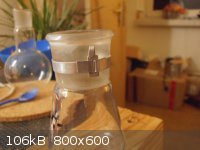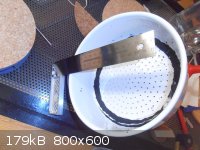Organikum
resurrected
    
Posts: 2329
Registered: 12-10-2002
Location: Europe
Member Is Offline
Mood: busy and in love
|
|
Springs and hooks and a Buchner with an issue
The first attached picture shows these nice aluminium hooks to use together with springs instead of Kecks.
I knew this exists but I was unable to ever find a seller. Now I found this nice flask and hope somebody here can tell me an address where to get some
50 to 100 of these aluminium pieces - for a reasonable price, this can only cost a few cents a piece not more.
So if anybody is in the know pls tell.
The second picture shows a 20cm Buchner I got today for € 10.-, looks like new if not somebody had somehow applicated this black material what is
elastic and probably rubber.
I did some small tests and thought to solve the problem by carbonisation, say to burn the shit off with a propane burner.
Any better ideas, warnings "Dont do this because...." tips?
Would be a pity if it got damaged, wouldn't it?
regards
/ORG


[Edited on 5-2-2013 by Organikum]
|
|
|
bahamuth
Hazard to Others
  
Posts: 384
Registered: 3-11-2009
Location: Norway
Member Is Offline
Mood: Under stimulated
|
|
If you have a heating cabinet that goes to 250-300C. it will do most organic polymers after prolonged exposure. Otherwise I would try a sulfuric acid
soak, with heating to about 100C. at first. If that don't work heat it harder in sulfuric acid. Heating locally with a blowtorch might crack the
perforated plate..
I also want some of those hooks
Any sufficiently advanced technology is indistinguishable from magic.
|
|
|
Endimion17
International Hazard
    
Posts: 1468
Registered: 17-7-2011
Location: shores of a solar sea
Member Is Offline
Mood: speeding through time at the rate of 1 second per second
|
|
Rubber on smooth ceramics... I'd take a plastic utensil and scrap the shit out of it. Traces can be removed with some organic solvent on a cotton
ball.
Those aluminium hooks, I've had two of them. Didn't last long. They could be made from a thin sheet...
[Edited on 5-2-2013 by Endimion17]
|
|
|
phlogiston
International Hazard
    
Posts: 1376
Registered: 26-4-2008
Location: Neon Thorium Erbium Lanthanum Neodymium Sulphur
Member Is Offline
Mood: pyrophoric
|
|
The aluminium hooks seem a bit elaborate to me. What is the advantage of these over other solutions?
If heat resistance: there are several types of steel snap-on clips for this purpose that should offer better heat resistance and are easier to install
and remove and won't suffer from metal fatigue as badly as aluminum.
Regarding the rubber:
(1) Freeze it, so it becomes hard and brittle and non-sticky. Then mechanically remove it.
(2) Try dissolving it with methylene chloride or chloroform
[Edited on 5-2-2013 by phlogiston]
-----
"If a rocket goes up, who cares where it comes down, that's not my concern said Wernher von Braun" - Tom Lehrer |
|
|
Doc B
Hazard to Others
  
Posts: 107
Registered: 5-4-2012
Member Is Offline
Mood: No Mood
|
|
I make similar fittings with those disposable steel pipe cleaners. The entwined fabric doesn't suffer from heat except applied flame and provides a
soft contact to the glass which lessens the risk of damage. Once applied to all joints, I just twist to lock and unlock.
Maybe the rubber is a solution to ill fitting papers? If it doesn't dissolve it might be there to provide an edge seal with the filter paper. My
Buchner is crap the liquids always creep under the edges.
|
|
|
Dr.Bob
International Hazard
    
Posts: 2665
Registered: 26-1-2011
Location: USA - NC
Member Is Offline
Mood: No Mood
|
|
When using a Buchner, always put the paper in the buchner , wet it with your solvent a moment before you use it, and then turn the vacuum on before
pouring any solution in it. If you do this properly, it will be rare that your solids will leak under the paper. The real trick is wetting it and
putting the vacuum on quiickly and then immediately pouring in some of the solution to keep the paper wet, and then don't ever let it get dry until
done. Also, using thicker paper helps, as it does not bleed vacuum as fast, so it holds down better.
|
|
|